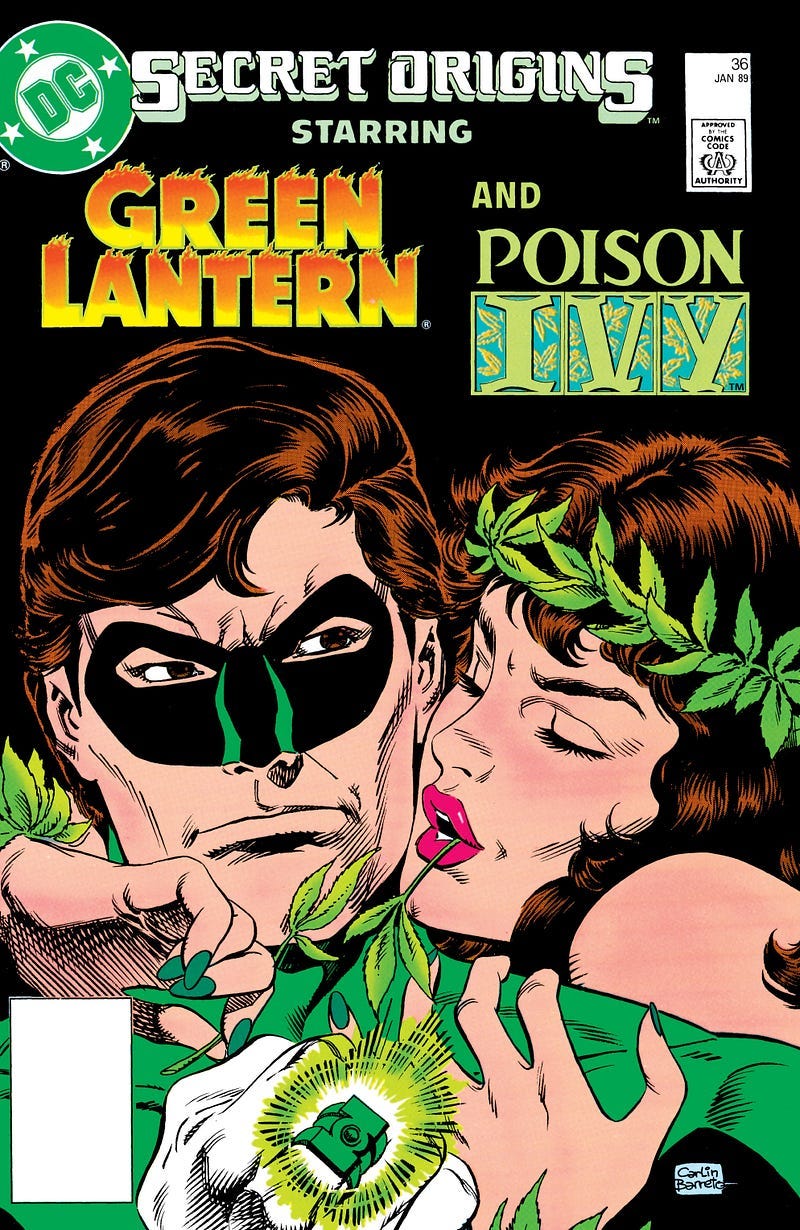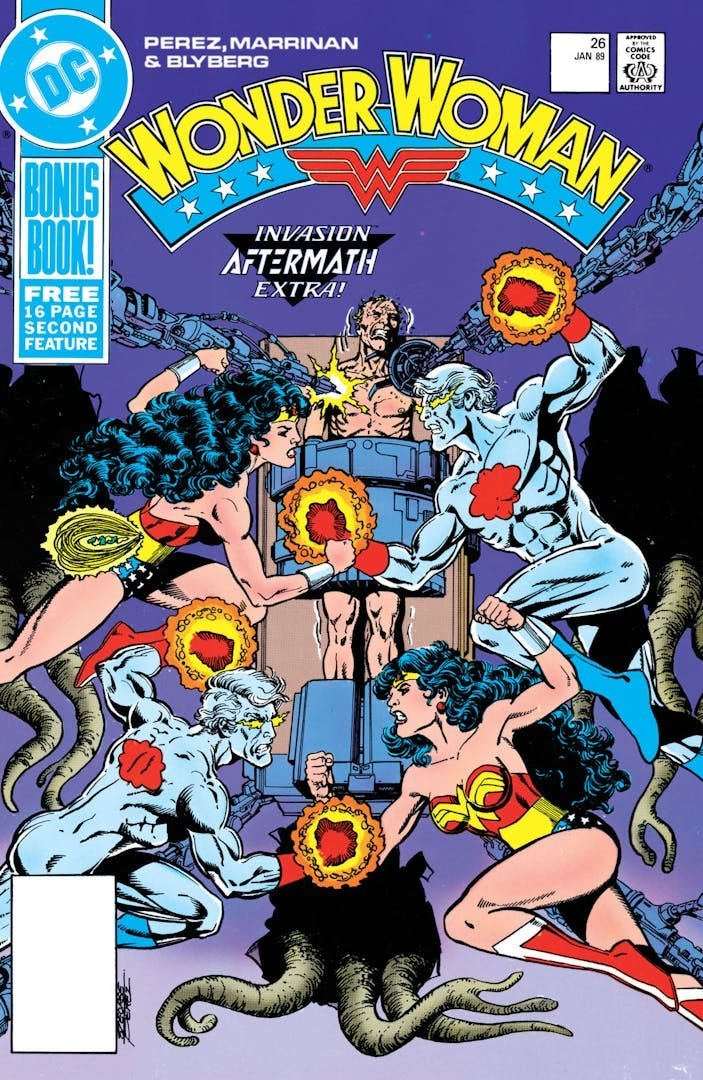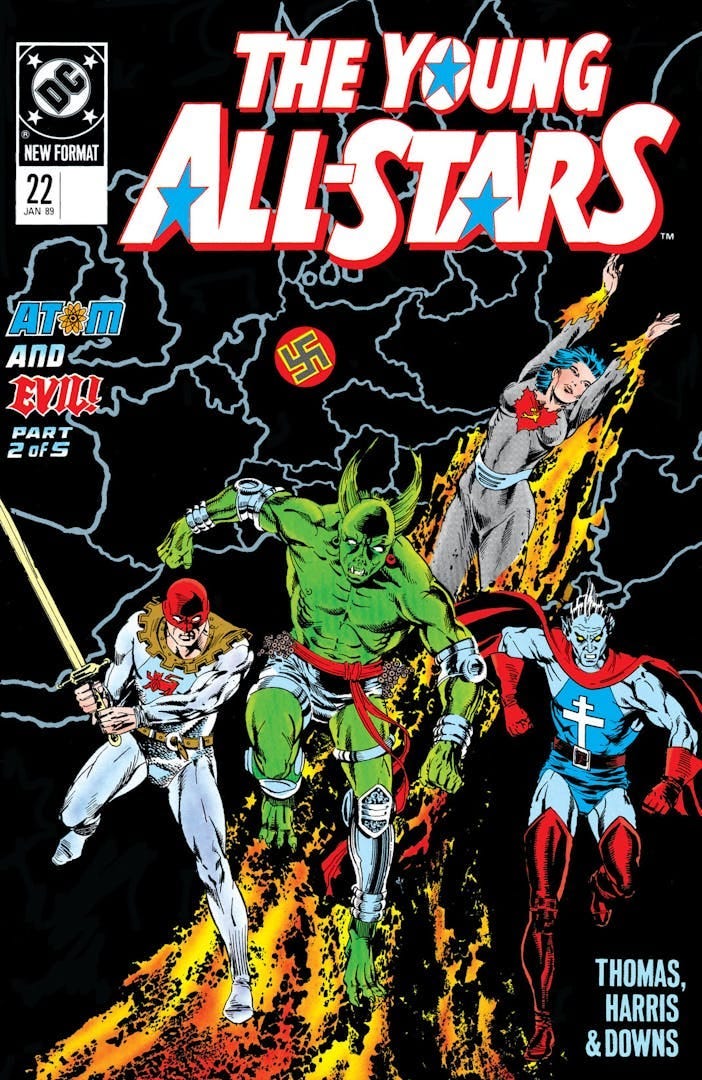Batman vs. Joker, Justice League vs. the Injustice League, plus more international heroes
Batman 429, Justice League International 23, Secret Origins 36, Wonder Woman 26, Young All-Stars 22
This week’s offerings bring us the final chapter of “Death in the Family”, a pair of Invasion! tie-ins, and the continuation of an ongoing Young All-Stars serial. Plus, we have perhaps the worst-aged issue of Secret Origins of its entire run. Let’s dive into some classic eighties comics.
Batman #429 by Jim Starlin, Jim Aparo, and Mike DeCarlo
This issue opens with CIA agent Ralph Bundy (who has become something of a regular in Starlin’s Batman) and Superman trying to talk down Batman’s plan to fight the Joker. They explain that Iranq has given him diplomatic immunity and that Superman is assigned to stop him should he try anything. After Bundy leaves, Superman apologizes for the death of Jason Todd, whom he correctly surmises was Robin.
Batman still plans to stop The Joker, but his decision is also to kill his archfoe before he can take another life. As Bruce Wayne, he uses his connections to get a seat inside the assembly for Joker’s address. Bruce assumes that Joker will try to kill everyone there.
Bruce is quickly proven right. Joker gives only a brief speech before he pulls off his jacket and reveals a gas gun. He starts to spray it, but the security guard next to him breaks the device. The Joker lashes out and rips off the man’s top, revealing Superman’s logo. Superman sucks up the gas and flies away to release it safely elsewhere. As soon as he’s gone, Joker goes to his backup, a small explosive, and several guns.
Batman intervenes, but the Joker manages to kill a few delegates before Batman gets to him. Batman chases Joker out of the building and to a waiting helicopter. One of his henchmen opens fire on Batman as they take off. The bullets hit both Joker and Batman (in the shoulder), as well as the pilot, killing him instantly. Batman knocks him away as the helicopter careens down over the water. Batman jumps free of the helicopter just before it crashes on the dock and bursts into flame. Superman pulls Batman from the water, but Batman screams at him to find the Joker’s body, even as he already knows the Joker will return again.
That’s how the issue ends, with Batman’s urge to kill the Joker unabated. The Joker disappears for essentially the next year and a half, outside a few oddball cameos that cannot fit chronologically after this story and before his return in Batman #450. (This also includes Arkham Asylum by Grant Morrison and Dave McKean.)
This issue also references the events of Batman: The Cult, also by Starlin, as happening sometime just before “Death in the Family.” There’s mention of Batman not being back at his full potential after Deacon Blackfire’s attempt to break him, which serves as a good stepping stone on the path the character would walk over the next year of comics before reaching “A Lonely Place of Dying.” But for Starlin, this would be his penultimate issue of the book, as his time at DC was fast drawing to a close.
Justice League International #23 by Keith Giffen, J.M. DeMatteis, Kevin Maguire, and Joe Rubinstein
It’s strange to see Justice League International keep up its regular comedic ways even in the midst of the crossover. This issue sees the team mostly doing cleanup, including Guy Gardner overestimating his abilities.
A lot of the issue is focused on the new Injustice League as they seek to steal an alien ship for their first actions as a team. The new team is all making their first post-Crisis appearances except for team leader Major Disaster. He is joined by Batman villains Cluemaster and Clock King, Challengers of the Unknown enemy Multi-Man, Flash villain Big Sir, and a normal tech guy called the Mighty Bruce.
This new Injustice League is ineffectual at the very best, despite Major Disaster’s power literally being the ability to cause major environmental disasters. None of them know how to fly the craft, and they’re quickly spotted by the JLI. Guy Gardner quickly starts ripping through the ship, assuming it is actually piloted by aliens. (Not that knowing it was villains would have stopped him.) He nearly causes it to crash, leaving Martian Manhunter to stop its descent. The villains are arrested and the team returns to their work, only for the black light to fall upon them as seen in other Invasion tie-ins.
As usual, simple plot summaries don’t really do justice to the writing of Justice League International. But the team of Giffen, DeMatteis, and Maguire produced beautiful work together. Next issue will see the last of it for quite awhile as Maguire draws half of an extra-length story.
Secret Origins #36 (see creators below)
This special issue of Secret Origins receives a bonus six-page story on top of the other two tales. Unfortunately for DC Infinite readers, the writer of that story was convicted of sex crimes, meaning this issue isn’t available online. In the last year, another of the named writers has also been accused of criminal abuse, leaving this book with perhaps the darkest creative team on any title not called Crimson Avenger.
“The Secret Origin of Green Lantern” by by James Owsley (Christopher Priest), M.D. Bright, and Jose Marzan Jr.
The opening tale is by the current creative team for Hal Jordan in Action Comics Weekly, but the first page is actually a classic page from Green Lantern / Green Arrow drawn by Neal Adams and written by Dennis O’Neil. That famous page sees a Black man ask Hal what he’s ever done for people with black skin, but we learn that another young man was nearby. This is Chip, who becomes the central figure in our story in the modern day.
Chip is assigned to find a new pilot for his design firm, nicknamed The Gremlins. When Hal applies for the position, Chip is enough of a fanboy to immediately recognize him without his mask. This freaks out Hal, but he eventually admits that Chip is right. We get Hal’s origin through explanations to Chip, even as he takes Chip flying with a temporary ring. They end up on Oa and battle a group of scavengers. Hal isn’t sure that he wants to take a job with anyone who knows everything about him, but Chip convinces him that it will work. The story ends with Hal meeting the rest of the team, including the company head Hawk, who thinks there’s something strange about Hal.
This establishes some of the supporting cast members that we’ve seen in recent Green Lantern stories, but it also seems to be a setup for an eventual new ongoing that Action Comics Weekly recently teased but wouldn’t actually happen for over a year. Even then, it was with a different creative team and a very different direction (although M.D. Bright would end up working on the book again.)
“A Piece of the Pie” by Gerard Jones and Joe Staton
We get some back story of Thomas Kalmaku in the second tale, the former sidekick of Green Lantern and now a cast member of New Guardians. He sits with his children and tells the tale of his life, learning how to work jets in Alaska and how he came to Coast City in search of his father’s missing partner. He also still acknowledges the nickname Pieface, instead of the creators using the chance here to erase that unfortunate and racist nickname from post-Crisis continuity.
He and Hal become friends. As Green Lantern, Hal helps him track down a lead on the missing man, but he throws the same punch that Kalmaku saw Hal throw. He deduces Hal’s secret identity. He tells Hal that he knows with the expectation that Hal will erase his memory, but Hal chooses to trust him as the one man who knows his secret.
This all feels a bit pointless in the current continuity, where Kalmaku has been divorced from the Green Lantern series, but it likely plays a role in why he would resurface years down the road in the next Green Lantern series, long after New Guardians is a distant memory.
“Pavane” by Neil Gaiman and Mark Buckingham
A month after the first issue of the Black Orchid mini-series and exactly a week before The Sandman #1, Neil Gaiman makes an appearance in Secret Origins to tell the origin of Poison Ivy. He’s joined by artist Mark Buckingham, working on his first American comic as far as I can tell. The pair is still three months away from creating their first Miracleman story, a series linking them through the next forty years of comics history. (And ultimately, will likely become an unfinished work after a decades-long wait for its return.) The story follows a “prison inspector” named Stuart who is actually a recruiter for Task Force X. He is there to see if the villain is suitable for the project. This involves a series of interviews, none of which sit well with the guards, even the one who clearly has a thing for Stuart.
The creative team uses this to hammer together a proper origin for the character from two different back stories (and even different names) in her pre-Crisis history. This includes combining her two previous names to make her Pamela Lillian Isley and to reveal that the famed teacher that tested poisons on her until she was immune was actually Jason Woodrue, the former villain now known as New Guardians’ Floro. This brings more of a link between her and other plant-based characters, although her connections with Swamp Thing are rarely ever actually explored.
Ultimately, she gets Stuart to allow her outside, where she grows plants and burns him with her touch. He still seems smitten with her, likely due to a cocktail of drugs, even as he writes a recommendation she be moved to Arkham Asylum. It’s a weird way to end it, as the character will spend almost a year in and out of the Suicide Squad, years before her future love interest and noted Suicide Squad member even debuts.
This issue plays around with sexual power dynamics between men and women, a theme that’s aged quite poorly due to the allegations against its writer. Yet, it clearly shows a level of sophistication not offered in the previous two stories, one which will eventually carry on to Gaiman’s second and final Secret Origins appearance in a special timed to the release of the Batman movie.
Wonder Woman #26 by George Perez, Chris Marrinan, and Will Blyberg / Tom Joyner, Neil Vokes, and Fred Butler
I’m curious if the way Perez plotted and scripted his comics changed when he brought on another artist. This issue shows a bit more consistency on the script side, even if artist Marrinan isn’t the best replacement for Perez based on styles.
Wonder Woman and Etta Candy are called in to a meeting as Steve Trevor is still missing after last month’s Captain Atom. (Keith Giffen and Cary Bates both get co-plotting credits due to the ties to Invasion! here.) The Durlans have taken him hostage, but Captain Atom swears to assist Diana in finding him.
Meanwhile, Hermes swears to correct the mistakes he made in Boston. He returns to Boston with the intention of using some of his power to repair the damage caused by the attack a few issues earlier. This draws the attention of a shadowy Bostonian who is none to happy to see him again.
Wonder Woman and Captain Atom manage to track down Steve with relative ease. The Lasso of Truth becomes a handy tool to expose the Durlans, especially when they attack the separated heroes by replicating their mission partner. Steve is freed, and Wonder Woman can head back to Boston.
The Creeper reveals himself as our shadowy figure and attacks Hermes. (I believe this is the first place the Creeper is marked as a Bostonian.) He attacks Hermes, but cannot do much to the god. But the god cannot do much back to him as his power is still focused on reassembling entire buildings. Wonder Woman arrives on the scene and again uses the Lasso of Truth to subdue her foe. The issue ends with the familiar black light of this month’s comics.
While I’ve determined his take on Wonder Woman isn’t quite what I want from the character, the scripting shows a marked improvement here. We will have to see if Perez maintained that consistency as his run continues.
This issue also includes a Bonus Book called “Legends of the Amazons” which feels like the least consequential story in a series of stories that feel like they have very little consequence. Set sometime in the past of the Amazons, likely before Diana’s birth, starts an Amazon named Janestra who dreams of flying. A demon is released who disguises himself as Icarus to trick her and tries to open Doom’s Doorway (as seen in much earlier issues of this series.) Janestra turns on the demon and slays it, but still dreams of flight.
It’s simple and rather one note, which is why it’s strange that this issue features the creative team that certainly went the farthest. Writer Tom Joyner didn’t have a really long career, but he would move on to two rather good creator-owned DC books Hammerlocke (featuring some of Chris Sprouse’s earliest art) and the vampire saga Scarlett. His most notable creation would be Damage, the new DC hero he co-created and wrote for his entire series run. He’s only did a handful of comics since, but he at least had a slightly noticeable place in DC history.
Penciler Neil Vokes didn’t have a huge DC career, instead doing a ton of independent work from the late eighties well into the 2020s. Other DC projects include a Congorilla limited series and an adaptation of Life, the Universe, and Everything from Douglas Adams’ legendary novel. His longest run on one title was on his own Eagle, likely followed by a place as one of several rotating artists on the Superman Adventures series in the late 90s and early 2000s.
Butler previously worked on the Bronze Tiger Bonus Book and would go on to ink about twenty or so comics in his short career, but that still shows a level of success at least a bit higher than a lot of Bonus Book creators.
It’s strange to see such talented creators produce such a lackluster Bonus Book. But the writing is already on the wall for the series, as next month’s Justice League International would mark the last Bonus Book.
Young All-Stars #22 by Roy and Dann Thomas, Ron Harris, and Bob Downs
This is a weirdly uneventful issue of the series with much of the page count devoted to origins for four new teenage heroes that would never be seen again after this arc. These international all-stars end up in a fight with the team after some misunderstanding after hearing Franklin Roosevelt cry out from his office.
From left to right, they are the British Squire — a normal human gifted his armor and sword by Shining Knight, the Chinese supernatural hero Kuei — named after a mythological being he barely resembles, the Russian Fireball — whose fire powers are connected to Tunguska, and Fantasmo — whose origins relate back to the marriage of human and elementals centuries earlier, in what is certainly a Wold Newton reference that I’m not getting. The team is assigned to accompany these “Young Allies” on yet another bond tour, although Roosevelt charges them with the knowledge that one foreign hero is secretly a traitor, even though this could also include Fury (of Greece) and Tsunami (of Japan) in the list. (Oddly, Flying Fox is glossed over entirely despite being Canadian.)
Meanwhile, Axis Amerika is revealed as Baron Blitzkrieg’s secret agents in the Nazi mission to steal the nuclear secrets. They already have one American hostage whose secrets are pried out by Sumo’s hypnotic abilities.
And that’s pretty much it. Everything else is devoted to some pointless fighting between the two hero teams and some time with Axis Amerika toying with the prisoner as he tries to escape. The Thomases have padded this story to the extreme, and it feels like it.
This proves to be a rather uneven week of DC titles. JLI is easily the best of the bunc,h with the final chapter of “Death in the Family” doing a lot to try to reshape Batman in directions that he thankfully would be pulled back from. Wonder Woman showed slight improvement while Young All-Stars failed to move along at all.
Next time, we see another debut as Mr. Miracle spins out of Justice League International in his second and longest-running series. Plus more from Animal Man, Plastic Man, and more.










"Unfortunately for DC Infinite readers, the writer of that story was convicted of sex crimes, meaning this issue isn’t available online. In the last year, another of the named writers has also been accused of criminal abuse,"
This has become the surest way to ruin someone's career, sometimes for good reasons and sometimes not, in the 21st century.